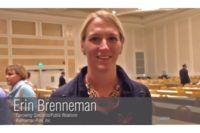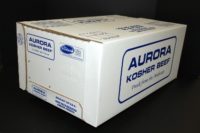Aurora Packing is a meatpacking plant in North Aurora, Ill., that specializes in high-end beef raised in the Midwest.
“As packinghouses go, we’re very small,” says Tim Sonne, plant engineer. “But what leaves here is high-quality Prime and Choice beef that is in demand from the finest restaurants, hotels and grocers in the U.S. We take pride in being able to deliver specialty cuts that have been trimmed, weighed and aged to exact specifications of these customers.”
Sides and quarters of high-quality beef are hung on hooks and moved by ceiling-mounted rails to the various processing stations. Beef halves weigh between 350 and 450 pounds, and beef quarters weigh between 200 and 250 pounds. Between 10 and 20 sides and quarters are on the rail system at any given time. Moving three quarters or two sides is about all one individual can push at time. Because of this limitation, it doesn’t take a lot of time before production can get bottlenecked.
“We typically rotate workers out from the rail line every two hours to give them a break. This was not especially efficient, but rotation of people kept us with the best efficiencies possible” says Sonne.
Sonne is a proponent of the Occupational Safety and Health Administration’s VPP (Voluntary Protection Program), and he has spent considerable time researching his potential options. VPP promotes effective worksite-based safety and health. Through VPP, management, labor and OSHA establish cooperative relationships at workplaces that have implemented a comprehensive safety- and health-management system. Acceptance of the company into VPP is OSHA’s official recognition of the outstanding efforts of employers and employees who have achieved exemplary occupational safety and health standards.
Sonne attended the AMI Expo, looking for a technology that would move sides of beef and fit within Aurora Packing’s worker-safety standards.
Using a Power Pusher with stainless-steel pusher attachments and some counterweights, Sonne says that one worker now moves the rails of beef sides all day long within their departments without “breaking a sweat.” The company no longer needs to rotate personnel every two hours.
Aurora Packing bought its first Power Pusher in December, 2009, and a second one in March, 2010. While it’s too soon to document any of the financial or safety ramifications, Aurora Packing has reported immediate approval from the employees.
The Power Pusher units help pull carts and sort quarters and sides onto both racks and rails. What the company likes is that it can buy the base Pusher unit and simply add attachments and options to get the desired push/pull capability. Since the base units remain the same, there is great interchangeability of tires, wheels and batteries.
Sonne says Aurora Packing has gone out of the way to look for this type of equipment that can take exposure completely away from workers.
“When you run a small, lean and mean operation you have to [operate this way],” he explains. “If we have one or two people out with vacations or illness, our production really takes a hit. We have found some pretty obscure pieces of equipment to help us keep competitive with our large adversaries.”
Protein Problems Solvers are field reports of practical application of technologies, contributed to The National Provisioner and written from the perspective of processors.
Get our new eMagazine delivered to your inbox every month.
Stay in the know with The National Provisioner's comprehensive coverage of the meat and poultry processing industry.
SUBSCRIBE TODAY!Copyright ©2024. All Rights Reserved BNP Media.
Design, CMS, Hosting & Web Development :: ePublishing






Report Abusive Comment